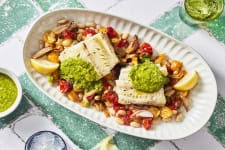For a fast and fancy meal that’s done in under 20 minutes, try out this easy recipe for broiled Wild Alaska Pollock fillets served with a vibrant Italian caper-parsley sauce. This sauce is an herbaceous, briny condiment that you can make with basic ingredients that you might already have in your kitchen. It’s the perfect complement to a broiled fillet of Wild Alaska Pollock. If you like, you can substitute a hearty white fish like Pacific halibut.
To make this a full meal, try broiling the fish alongside blanched green beans, snap peas, or zucchini matchsticks.
The WAC recipe team featured this Caper-Parsely Sauce in a live event! Watch the recording of the cooking demo to see how it's made.
Chef's note: If you don't have parsley, you can swap it out for other tender herbs like mint or basil — just keep the ratios of herbs-to-capers about the same so that the sauce maintains a good balance of flavors.






